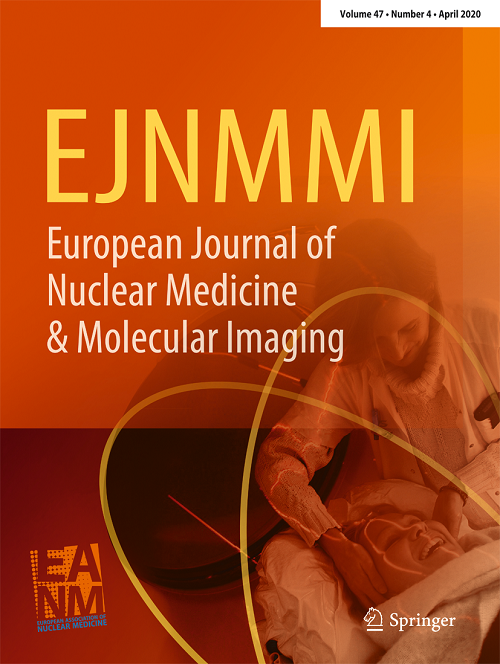Divergent prognostic utility of metabolic risk scores in large B-cell lymphoma subtypes: a real-world analysis.
IF 7.6
1区 医学
Q1 RADIOLOGY, NUCLEAR MEDICINE & MEDICAL IMAGING
European Journal of Nuclear Medicine and Molecular Imaging
Pub Date : 2025-06-16
DOI:10.1007/s00259-025-07368-y
引用次数: 0
Abstract
PURPOSE Large B-cell lymphomas (LBCL) include diffuse large B-cell lymphoma, not otherwise specified (DLBCL, NOS), and subtypes such as transformed non-Hodgkin's lymphoma (tNHL), primary mediastinal B-cell lymphoma (PMBL), and double/triple-hit lymphomas (DHL/THL). While metabolic risk scores based on metabolic tumor volume (MTV) have demonstrated prognostic value in DLBCL, NOS, their applicability to other LBCL subtypes remains unclear. METHODS Baseline [18F]FDG-PET/CT scans of LBCL patients treated with R-CHOP regimens at our institution were retrospectively analyzed. Metabolic parameters, including MTV, lesion dissemination (SDmax) and tumor surface volume ratio were calculated for each histological subgroup. Four metabolic risk scores-the international metabolic prognostic index (IMPI), MTV/WHO PS, MTV/SDmax and Clinical PET model- were applied to calculate progression risk in LBCL subtypes. Harrell's C-index evaluated the prognostic performance. A multivariable model was developed for tNHL. RESULTS We included tNHL (n = 88), DHL/THL (n = 32), PMBL (n = 26) and others (n = 49), and compared them to a cohort of previously published DLBCL, NOS (n = 355). IMPI demonstrated the highest C-index amongst the metabolic risk scores in tNHL for progression-free survival (PFS), overall survival, time to progression and progression of disease within 12 months, but was outperformed by the IPI. For DHL/THL the highest C-indices were observed for MTV/WHO PS. For PMBL the clinical PET score showed the highest C-indices. SDmax improved prognostic predictions in PMBL and tNHL, but not in DHL/THL. Multivariate analysis identified independent predictors of PFS in tNHL, including IPI and SUVmean. CONCLUSION Metabolic risk scores show variable prognostic value across LBCL subtypes. Subtype-specific metabolic models may enhance personalized risk stratification and guide treatment approaches.代谢风险评分在大b细胞淋巴瘤亚型中的不同预后效用:一项现实世界分析。
目的:大b细胞淋巴瘤(LBCL)包括弥漫性大b细胞淋巴瘤(DLBCL, NOS),以及转化型非霍奇金淋巴瘤(tNHL)、原发性纵隔b细胞淋巴瘤(PMBL)和双/三发淋巴瘤(DHL/THL)。虽然基于代谢肿瘤体积(MTV)的代谢风险评分在DLBCL、NOS中具有预后价值,但其对其他LBCL亚型的适用性尚不清楚。方法回顾性分析我院接受R-CHOP方案治疗的LBCL患者FDG-PET/CT基线扫描[18F]。计算各组织亚组的代谢参数,包括MTV、病变播散(SDmax)和肿瘤表面体积比。采用国际代谢预后指数(IMPI)、MTV/WHO PS、MTV/SDmax和临床PET模型四种代谢风险评分来计算LBCL亚型的进展风险。Harrell c指数评估预后。建立了tNHL的多变量模型。结果我们纳入了tNHL (n = 88)、DHL/THL (n = 32)、PMBL (n = 26)和其他(n = 49)患者,并将其与先前发表的DLBCL、NOS (n = 355)患者进行比较。在tNHL的无进展生存期(PFS)、总生存期、进展时间和12个月内疾病进展的代谢风险评分中,IMPI显示出最高的c指数,但IPI优于IMPI。对于DHL/THL, MTV/WHO PS的c -指数最高,对于PMBL,临床PET评分的c -指数最高。SDmax改善了PMBL和tNHL的预后预测,但对DHL/THL没有改善。多变量分析确定了tNHL患者PFS的独立预测因子,包括IPI和SUVmean。结论代谢风险评分在不同LBCL亚型中具有不同的预后价值。亚型特异性代谢模型可以增强个性化的风险分层和指导治疗方法。
本文章由计算机程序翻译,如有差异,请以英文原文为准。
求助全文
约1分钟内获得全文
求助全文
来源期刊
CiteScore
15.60
自引率
9.90%
发文量
392
审稿时长
3 months
期刊介绍:
The European Journal of Nuclear Medicine and Molecular Imaging serves as a platform for the exchange of clinical and scientific information within nuclear medicine and related professions. It welcomes international submissions from professionals involved in the functional, metabolic, and molecular investigation of diseases. The journal's coverage spans physics, dosimetry, radiation biology, radiochemistry, and pharmacy, providing high-quality peer review by experts in the field. Known for highly cited and downloaded articles, it ensures global visibility for research work and is part of the EJNMMI journal family.

 求助内容:
求助内容: 应助结果提醒方式:
应助结果提醒方式:


